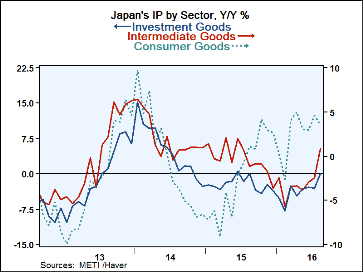 Global| Oct 17 2016
Global| Oct 17 2016Japan's IP Index Makes Smaller Gain But Still Looks Solid
Summary
Japan's industrial production gain is at 1.3% month-to-month in August, lower than the preliminary 1.5% that had been reported initially. Still, (as the chart shows) year-over-year gains in IP are beginning to take hold across all [...]
 Japan's industrial production gain is at 1.3% month-to-month in August, lower than the preliminary 1.5% that had been reported initially. Still, (as the chart shows) year-over-year gains in IP are beginning to take hold across all three main sectors.
Japan's industrial production gain is at 1.3% month-to-month in August, lower than the preliminary 1.5% that had been reported initially. Still, (as the chart shows) year-over-year gains in IP are beginning to take hold across all three main sectors.
All of IP manufacturing, consumer goods and intermediate goods all show output as accelerating steadily from 12- month to six-month to three-month. Investment goods output is not on the same accelerating path as it is up by just 0.1% over 12 months, accelerates to an 11.4% pace of six-month, then cuts back to grow at only a 4.4% annualized rate over three months. We have also seen some irregularities with capital goods output and orders in Europe. With the economy globally not growing very fast, the demand for capital equipment is taking a hit despite the length of the expansion. By expansion length, we would expect capital goods output to be ramping up at this stage. But because of such weak demand globally and global conditions of excess supply, capital goods output cannot get out of its own way.
Still, growth in the current quarter for Japanese output is pretty solid and that is despite China, a higher growth country, but one with a struggling economy, being its main trading partner. Two months into Q3, Japan's output is growing at a 4.5% pace. It is led by consumer goods and intermediate goods with investment goods lagging at a 1.5% rate of growth.
The problems with investment demand can be seen in Japan's own economic performance. In the far right hand column of the table, we express each sector's IP index as a percentile of its cycle peak pace. Overall IP is still 17 percentage points below it cycle peak. The same is true for manufacturing. Consumer goods and intermediate goods; each are 17 percentage points below their cycle peak. Investment goods output stands 22 percentage points below its past cycle peak.
Demand has been adversely impacted by the weakness in the business cycle and there are clear adverse effects that blow back to the output sector then feed back into the economic system as lower demands for resources include less demand to hire and to pay labor. Supply and demand are caught in a web of self-reinforcing weakness.
Summing up
In August, Japan's output revival is encouraging, despite its being scaled back. That revival also seems to have some strong elements of trend recovery behind it. The fly in the ointment is the still a weak investment goods sector that seems to be weighed down by globally weak demand conditions and is beyond Japan's control.

Robert Brusca
AuthorMore in Author Profile »Robert A. Brusca is Chief Economist of Fact and Opinion Economics, a consulting firm he founded in Manhattan. He has been an economist on Wall Street for over 25 years. He has visited central banking and large institutional clients in over 30 countries in his career as an economist. Mr. Brusca was a Divisional Research Chief at the Federal Reserve Bank of NY (Chief of the International Financial markets Division), a Fed Watcher at Irving Trust and Chief Economist at Nikko Securities International. He is widely quoted and appears in various media. Mr. Brusca holds an MA and Ph.D. in economics from Michigan State University and a BA in Economics from the University of Michigan. His research pursues his strong interests in non aligned policy economics as well as international economics. FAO Economics’ research targets investors to assist them in making better investment decisions in stocks, bonds and in a variety of international assets. The company does not manage money and has no conflicts in giving economic advice.






